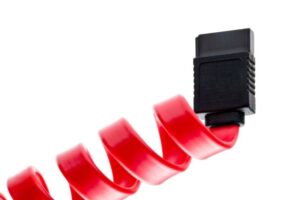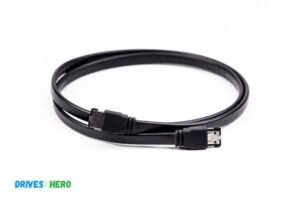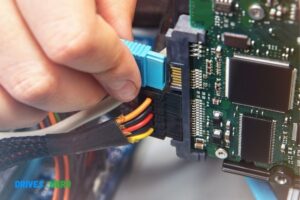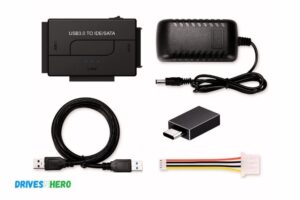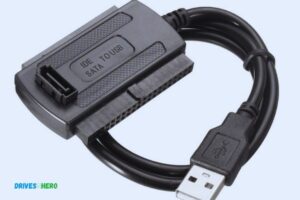What is a Sata 3 Cable? A Serial ATA 3 Cable!
A SATA 3 cable, also known as a Serial ATA 3 cable, is a technology interface used for connecting a computer’s host bus adapters to mass storage devices such as hard disk drives, optical drives, and solid-state drives.
SATA 3 cables are the third generation of SATA technology, providing data transfer rates of up to 6 Gbps.
They are backward compatible with SATA 2 and SATA 1 devices, allowing for flexibility and utility in a variety of hardware configurations.
SATA 3 cables play a critical role in modern computing, providing high-speed connections between the computer and its storage devices.
Their backward compatibility makes them a versatile solution for various hardware configurations, while their support for advanced features like hot-plugging and native command queuing enhances overall system performance.
11 Features Of SATA 3 Cables
| Feature | Description |
|---|---|
| Type | Data Cable |
| Name | SATA 3 |
| Full Form | Serial Advanced Technology Attachment 3 |
| Data Transfer Speed | 6 Gbps |
| Purpose | Connects motherboard to hard drives, solid state drives, and optical drives |
| Cable Length | Typically up to 1 meter |
| Connectors | Typically two, one for the device(hard drive, SSD, etc.) and one for the motherboard |
| Hot Plugging | Supports hot plugging (connecting or disconnecting while the system is running) |
| Color | Usually red, but can be any color |
| Upgrade | Backwards compatible with SATA 2 and SATA 1 |
| Use | Widely used in desktop and laptop computers |
Key Takeaway

Five Facts About SATA 3 Cables
Understanding Sata 3 Technology
An explanation of what a SATA 3 cable is and its advantages in terms of speed and data transfer rates. Discover how this technology enhances the performance of storage devices and maximizes efficiency.
Evolution of SATA Cables:
- SATA (Serial ATA) cables have gone through several iterations, with each version offering improved performance and features. SATA 3, also known as SATA III or SATA 6Gbps, is the latest and fastest version available.
- SATA 3 cables were introduced as an upgrade to SATA 2 to provide faster data transfer rates and better overall performance for modern storage devices.
Advantages of SATA 3 over previous versions:
- Increased Speed: SATA 3 cables support data transfer rates of up to 6 gigabits per second (Gbps), twice as fast as SATA 2 cables. This faster speed allows for quicker file transfers and improves overall system responsiveness.
- Larger Bandwidth: With a larger bandwidth, SATA 3 cables can handle higher volumes of data, making them ideal for large file transfers, gaming, and multimedia applications.
- Backward Compatibility: SATA 3 cables are backward compatible with SATA 2 and SATA 1 devices. This means you can use a SATA 3 cable with older SATA drives or motherboards without any issues.
How SATA 3 cables support faster data transfer rates:
- Enhanced Signal Quality: SATA 3 cables use improved signaling technology, minimizing signal interference and ensuring reliable data transmission. This helps to maintain high-speed connections and reduces the likelihood of data errors or corruption.
- Thinner Cables: SATA 3 cables are thinner and more flexible compared to previous versions, allowing for better airflow within the computer case and enabling easier cable management.
- Increased Cable Length: SATA 3 cables have a longer maximum cable length compared to SATA 2, which means you can have more flexibility in arranging your storage devices within your system.
- Compatible with Solid State Drives (SSDs): SATA 3 cables are designed to support the higher speed capabilities of modern SSDs, allowing them to deliver their full performance potential.
- Improved Power Efficiency: SATA 3 cables are designed to be more energy-efficient, consuming less power when transferring data. This can result in reduced heat generation and lower energy costs for your system.
SATA 3 cables represent a significant evolution in storage technology, offering faster data transfer rates, better performance, and compatibility with a wide range of devices.
Whether you’re building a new computer or upgrading an existing one, opting for SATA 3 cables will ensure that you experience the full benefits of modern storage devices.
Differentiating Sata 3 Cables From Other Types
A SATA 3 cable is a type of data transfer cable specifically designed for SATA 3 devices. It allows for faster data transfer speeds and is distinguishable from other cables by its unique connectors.
SATA (Serial Advanced Technology Attachment) cables are an essential component in connecting storage devices like hard drives and solid-state drives to a computer’s motherboard.
They have evolved over the years, with SATA 3 being the latest standard.
We will explore the key differences between SATA 3 cables and their predecessors, SATA 2 and SATA 1, focusing on physical connectors, data transfer speeds, and compatibility with older devices.
Comparing Sata 3 With Sata 2 And Sata 1 Cables:
- SATA 3 cables feature a smaller and sleeker connector compared to the larger and bulkier connectors of SATA 2 and SATA 1 cables. This design change allows for better airflow within the computer case and easier cable management.
- SATA 3 cables are backward compatible, meaning they can be used with SATA 2 and SATA 1 devices. However, it is worth noting that the overall data transfer speed will be limited to the capabilities of the lower standard.
- For example, if a SATA 3 cable is connected to a SATA 2 device, the maximum transfer speed will be limited to SATA 2 speeds.
- SATA 3 cables support higher data transfer rates compared to their previous iterations. While SATA 2 cables are capable of speeds up to 3 gigabits per second (Gbps), SATA 3 cables can achieve speeds of up to 6 Gbps.
- This increased bandwidth allows for faster data transfer and improved overall system performance.
Exploring The Differences In Physical Connectors And Data Transfer Speeds:
- SATA 3 cables typically feature a thinner and more flexible cable design, making them easier to route and manage within the computer case.
- The connectors are also designed to be more durable and reliable, ensuring a secure connection between the storage device and the motherboard.
- The higher data transfer speed of SATA 3 cables enables faster access to files and programs, resulting in reduced loading times and improved system responsiveness.
- This is particularly beneficial for tasks that involve data-intensive operations such as video editing, gaming, and file transfers.
- SATA 3 cables utilize a different signaling method called “8b/10b encoding” compared to SATA 2 and SATA 1 cables.
- This encoding method allows for more efficient data transmission and helps to minimize errors during data transfer.
Compatibility Of Sata 3 Cables With Older Devices:
- SATA 3 cables are designed to be backwards compatible with SATA 2 and SATA 1 devices, ensuring that they can be used interchangeably without any issues.
- This compatibility is possible because the physical connectors and pin configurations remain the same across all SATA generations.
- When using a SATA 3 cable with an older SATA 2 or SATA 1 device, it’s essential to keep in mind that the performance will be limited by the slower device’s capabilities.
- However, it is still beneficial to use a SATA 3 cable as it provides future-proofing and allows for easy upgrades to newer devices without the need to replace the cables.
SATA 3 cables offer improved physical connectors, higher data transfer speeds, and compatibility with older storage devices.
Whether you are upgrading your system or building a new one, utilizing SATA 3 cables can enhance performance and ensure seamless connectivity for your storage devices.
Factors Influencing The Performance Of Sata 3 Cables
SATA 3 cables play a crucial role in determining the performance of your system. Factors such as cable length, quality, and interference can greatly impact the overall speed and efficiency of data transfer.
Understanding these influences is essential for optimizing your system’s performance. SATA 3 cables play a crucial role in data transmission between a computer’s motherboard and storage devices.
The performance of these cables can be influenced by several factors, each impacting the overall efficiency and reliability of data transfer.
Let’s delve into the key factors that determine the performance of SATA 3 cables:
Cable Length And Its Impact On Data Transmission
The length of a SATA 3 cable can significantly affect its performance and the overall data transmission speed.
Here are some key considerations regarding cable length:
- Shorter cables are generally more efficient in transmitting data as they minimize signal loss and interference.
- Longer cables increase the chances of signal degradation and data errors, leading to slower transfer speeds and potential data loss.
- It is recommended to keep the cable length as short as possible, particularly when transferring large amounts of data or in demanding applications.
Understanding Data Integrity And Error Rates
Data integrity is crucial when it comes to SATA 3 cables, as it ensures the accuracy and reliability of data transmission.
Here are some important points to note:
- SATA 3 cables are designed to provide high data integrity, minimizing the occurrence of errors during transmission.
- The error rate of a cable indicates its reliability in transmitting data correctly. Lower error rates are desirable for seamless and error-free data transfer.
- Factors such as cable quality, length, and electromagnetic interference can impact data integrity and increase the error rate.
- Quality cables with better shielding and reduced crosstalk help maintain data integrity, resulting in lower error rates.
The Role Of Quality Cables And Their Impact On Performance
The quality of SATA 3 cables directly influences their performance in terms of data transmission speed, reliability, and durability.
Consider the following aspects:
- High-quality cables are designed with better shielding, enhanced connectors, and improved insulation, resulting in reduced signal loss and electromagnetic interference.
- Quality cables can provide faster data transfer rates, allowing for quicker access to stored information and improved system performance.
- Investing in reliable, well-built SATA 3 cables enhances the overall stability and longevity of the data transfer process, minimizing the risk of errors or connection failures.
The performance of SATA 3 cables can be influenced by factors such as cable length, data integrity, and cable quality.
Understanding these factors helps in making informed choices when selecting and utilizing SATA 3 cables, ensuring optimal data transmission speed, reliability, and overall system performance.
Factors To Consider When Choosing A Sata 3 Cable
A SATA 3 cable is an essential component for connecting storage devices to a computer. When choosing one, consider factors like cable length, compatibility with your devices, and the need for data transfer speed.
Cable length and its effect on signal quality:
The length of a SATA 3 cable can impact the quality of the signal being transmitted.
Here are some key points to consider:
- Longer cables can result in signal degradation and slower data transfer rates.
- SATA 3 cables come in various lengths, ranging from 6 inches to several feet.
- For optimal performance, it is recommended to choose a cable length that is as short as possible while still meeting your needs.
- Keep in mind that using excessively long cables can lead to data errors or even device failure.
- If you require a longer cable due to your specific setup, consider using a signal booster or a SATA 3 cable with better shielding to mitigate potential signal loss.
Differentiating between SATA 3 cables and SATA 3 compatible devices:
It is important to understand the distinction between SATA 3 cables and SATA 3 compatible devices.
Here are some key points to help you differentiate:
- SATA 3 cables are used to connect storage devices, such as hard drives and solid-state drives, to a motherboard or other storage controllers.
- These cables are backward compatible with previous versions of SATA (SATA 1 and SATA 2), but they are optimized for SATA 3’s higher speed and performance capabilities.
- On the other hand, SATA 3 compatible devices refer to the hardware components that support the SATA 3 standard.
- The devices themselves, such as hard drives and SSDs, must have SATA 3 interfaces to take full advantage of the increased bandwidth and faster data transfer speeds.
- To ensure compatibility and maximize performance, it is essential to use SATA 3 cables with SATA 3 compatible devices.
Exploring options for different cable designs and materials:
SATA 3 cables offer a range of options when it comes to designs and materials.
Consider the following factors:
Cable design:
- SATA 3 cables are available in two main designs: straight and angled connectors.
- Straight connectors are ideal for most setups, connecting devices directly to the motherboard.
- Angled connectors, such as right-angle or side-angle connectors, are useful in cramped spaces or when the cable needs to be bent at sharp angles.
Cable materials:
- SATA 3 cables are typically made of either copper or aluminum.
- Copper cables offer better conductivity and are generally preferred for optimal signal transmission.
- Aluminum cables can be more affordable, but they may not provide the same level of performance or durability as copper cables.
- Additionally, consider the quality of the cable’s shielding, which helps minimize electromagnetic interference and signal loss.
Remember, selecting the right SATA 3 cable involves considering factors like cable length, compatibility with SATA 3 devices, and cable design and materials.
By understanding these considerations, you can ensure efficient data transfers and optimal performance for your storage devices.
Troubleshooting Issues With Sata 3 Cables
A SATA 3 cable is a high-speed data cable used to connect storage devices to a computer. Troubleshooting issues with these cables involve checking for loose connections, cable damage, or compatibility problems with the devices.
When it comes to troubleshooting issues with SATA 3 cables, it’s important to understand the common problems that may arise, as well as the solutions to improve cable performance.
Additionally, maintaining optimal cable performance is crucial to ensure smooth data transfers.
We will discuss the common problems encountered with SATA 3 cables, provide solutions for cable performance issues, and offer tips for maintaining their optimal performance.
Common Problems Encountered With Sata 3 Cables:
- Loose connection: A loose connection between the SATA 3 cable and the device can result in data transfer issues. Ensure that the cable is firmly connected to both the motherboard and the storage device.
- Cable length and quality: Longer cables or poor-quality cables can lead to signal degradation and decreased data transfer speeds. Use high-quality cables and keep the cable length as short as possible for optimal performance.
- Cable damage: Physical damage to the SATA 3 cable, such as bends, kinks, or frayed wires, can lead to connection problems and data loss. Inspect the cable regularly and replace any damaged cables promptly.
Solutions For Cable Performance Issues:
- Check for firmware and driver updates: Ensure that your device’s firmware and drivers are up to date, as outdated software can result in compatibility issues and decreased performance. Visit the manufacturer’s website for the latest updates.
- Use a different SATA port: If you are experiencing performance issues, try connecting the SATA 3 cable to a different port on your motherboard. Sometimes, certain ports can have better compatibility and performance.
- Consider using a shielded cable: Shielded SATA 3 cables help to minimize electromagnetic interference, which can improve signal integrity and prevent performance issues. Consider using shielded cables in high-interference environments.
Tips For Maintaining Optimal Cable Performance:
- Avoid excessive bending: Excessive bending or twisting of the SATA 3 cable can cause damage to the internal wires and result in connection problems. Handle the cable with care and avoid sharp bends or tight twists.
- Organize cable routing: Proper cable management and routing can help reduce interference and improve airflow in your system. Keep the SATA 3 cables away from power cables and make sure they are not tangled or squeezed tightly.
- Regularly inspect and replace damaged cables: Conduct regular visual inspections of the SATA 3 cables and replace any damaged cables immediately. This ensures reliable and high-speed data transfers.
- Keep cables away from heat sources: Heat can negatively impact cable performance and cause signal loss. Keep the SATA 3 cables away from heat sources like CPU heatsinks or exhaust fans to maintain optimal performance.
By understanding the common problems associated with SATA 3 cables, implementing the suggested solutions, and maintaining proper cable care, you can troubleshoot issues and ensure optimal performance for your data transfers.
Future Of Sata 3 Cables And Possible Alternatives
A SATA 3 cable is a data transfer cable commonly used in computer systems. It provides faster data transfer speeds compared to its predecessors.
In the future, alternative cables like SATA Express and NVMe may provide even higher speeds and improved performance.
As technology continues to advance, so does the need for faster and more efficient data transfer. SATA 3 cables have been widely used in the computer industry, but what does the future hold for this technology?
Let’s take a look at potential advancements in SATA technology and explore alternative data transfer technologies that may replace or complement SATA cables.
Potential Advancements In Sata Technology:
Increased data transfer speeds: One possible future for SATA cables is the development of higher data transfer speeds.
With the demand for faster and more reliable data transfer growing, manufacturers may introduce SATA cables with even greater speeds than the current SATA 3 standard, potentially reaching SATA 4 or higher.
Improved power efficiency: Another area of improvement for SATA cables is power efficiency. As technology becomes more energy-conscious, future SATA cables may be designed to consume less power while maintaining high-speed data transfer.
This could result in more energy-efficient and environmentally friendly computing systems.
Stronger construction and durability: Another potential advancement in SATA technology is the development of stronger and more durable cables.
Future SATA cables may be designed to withstand harsher conditions, reducing the risk of damage during installation or everyday use. This could lead to longer-lasting and more reliable connections.
Exploring Alternative Data Transfer Technologies:
NVMe: Non-Volatile Memory Express (NVMe) is a data transfer protocol specifically designed for solid-state drives (SSDs). It offers significantly faster transfer speeds compared to SATA, making it an attractive alternative for future storage devices.
NVMe utilizes PCIe lanes instead of SATA cables, enabling it to achieve higher performance levels.
USB 3.2: Universal Serial Bus (USB) technology has been widely adopted for various devices, including storage drives. USB 3.2, which utilizes USB Type-C connectors, offers faster data transfer speeds compared to previous versions.
With ongoing advancements in USB technology, USB 3.2 could potentially become a viable alternative to SATA for certain applications.
Prospects For The Future Of Sata Cables:
Integration with emerging technologies: SATA cables may continue to be an integral part of computer systems, especially in traditional desktop and laptop setups.
While alternative technologies may emerge, SATA cables may still be widely used in conjunction with new developments, such as hybrid solutions that combine SATA and NVMe technologies.
Legacy compatibility: The wide adoption of SATA technology over the years means that many devices and systems are still compatible with SATA cables.
This legacy compatibility may ensure the continued use of SATA cables in the foreseeable future, particularly in scenarios where upgrading or replacing existing systems may not be economically feasible.
Coexistence and diversification: It is also possible that future storage solutions will offer a mix of different data transfer technologies, including SATA cables, NVMe, and USB.
Rather than replacing SATA entirely, these technologies may coexist and cater to different needs and preferences, providing users with a range of options to choose from.
As technology continues to evolve, the future of SATA 3 cables remains uncertain.
However, with potential advancements in SATA technology and the emergence of alternative data transfer technologies, the landscape of data storage and transfer will undoubtedly undergo significant changes.
Whether SATA cables continue to play a dominant role or make way for newer technologies, the goal remains the same – faster and more efficient data transfer.
FAQ On What is a Sata 3 Cable
What is the Difference between a Sata 3 Cable And Other Sata Cables?
SATA 3 cables are the latest type of SATA cable, providing a data transfer speed of up to 6 Gbps compared to previous generations that offered only 1.5 or 3 Gbps.
This increased speed makes it ideal for applications requiring high levels of performance. Additionally, SATA 3 cables have additional pins which provide faster power delivery and improved error-correction capabilities.
How Do I Know If My Computer Has a Sata 3 Port ?
To find out if your computer has a SATA 3 port, check the specifications of your motherboard. You can typically find this information in the manual or online.
Additionally, you may be able to see the ports on the back panel of your computer and identify them based on their shape and size.
Are There Any Compatibility Issues With Using a Sata 3 Cable on an Older Device ?
Yes, there can be compatibility issues with using a SATA 3 cable on an older device because SATA 3 cables are not backwards compatible with previous versions of the Serial ATA interface.
Is It Necessary to Use a Sata 3 Cable for Optimal Performance ?
No, it is not necessary to use a SATA 3 cable for optimal performance. Regular SATA cables will work just fine. However, if you need higher transfer speeds, then using a SATA 3 cable can help with that.
Conclusion
To sum it up, the SATA 3 cable plays a crucial role in ensuring fast and efficient data transfer between your storage devices and the motherboard.
This advanced cable technology offers speeds up to 6 Gbps, making it a significant upgrade from the previous SATA generations.
By utilizing high-quality materials and advanced connectors, the SATA 3 cable minimizes data loss and signal interference, resulting in enhanced performance and reliability for your computer system.
Moreover, its compatibility with SATA 2 and SATA 1 devices makes it a versatile choice for both new and older systems.
When setting up your computer or upgrading your storage devices, investing in a reliable and efficient SATA 3 cable is definitely worth considering.
So, ensure that you choose a high-quality cable that meets the required specifications and enjoy the benefits of faster data transfers and improved system performance.

